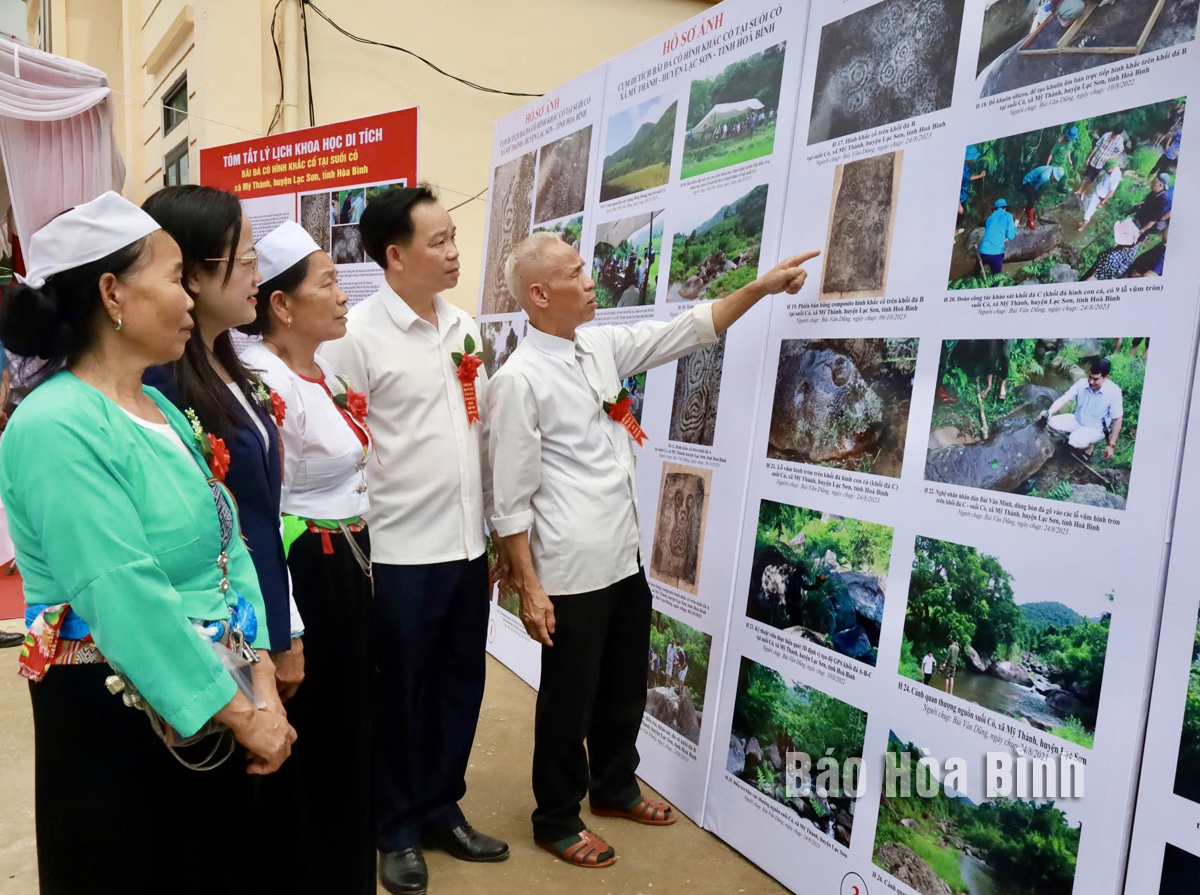
Residents of Muong Co village in My Thanh commune, Lac Son district have been delighted to learn that the ancient rock carvings at the local Co stream were officially designated a provincial-level archaeological site.
A display of
the newly designated provincial archaeological site of ancient rock carvings at
Suoi Co, exhibited at the My Thanh People's Committee.
Emphasising the significance of the site, Bui
Van Toi, Vice Chairman of the communal People’s Committee, said Muong Co is an
ancient land with a long-standing history of human settlement. The central area
of the site was once a dense forest, surrounded by rolling hills. The rock
engravings were discovered during local agricultural activities.
Co stream stretches approximately six kilometres
from Mount Voi through several hamlets – Chum, Ram, Co Giua, Vo Co, and Bui
Ruong – before emptying into Canh Tang lake. Surveys and research in the area
uncovered two engraved rock formations roughly 25 metres apart. A further
granite boulder was later identified, partially buried in the ground.
Preliminary assessments by archaeologists
suggest that the carvings date back to Vietnam’s prehistoric and early historic
periods, approximately 2,000 years ago.
Among the three, one prominent hexagonal stone
features a large carving with clearly defined incisions, including a stylised
figure with an exaggerated belly, arms raised skyward. Above each arm are
concentric circles with central dots – motifs characteristic of Dong Son bronze
culture. The second rock features four distinct sets of similar carvings, while
the third resembles a fish, marked by nine concave holes, referred to locally
as the "doong stone."
According to local tradition, annual rituals are
conducted at a small shrine located about 100 metres from the carved stones.
Dr Nguyen Viet, Director of the Centre for
Southeast Asian Prehistory, said from an archaeological perspective, these rock
carvings represent one of the rare traces of artistic and technical expression
in the prehistoric–early historic era. They indicate a significant cognitive
leap in how ancient communities in Hoa Binh’s heartland engaged with their
natural surroundings by turning natural stone surfaces into artificial spaces.
Bui Thi Dien, head of the women’s union in Ram
hamlet, added that like many here, she recognises the responsibility to
preserve the site and protect its surroundings, maintaining their natural
state.
Nguyen Thi Linh Ngoc, Deputy Director of the
provincial Department of Culture, Sports and Tourism, noted that the site holds
considerable value for research on Vietnam’sand even the world’s
prehistory. She stressed the importance of ongoing preservation and called for
expanded surveys to uncover further rock art in surrounding areas to ensure no
ancient heritage is left undocumented.
Phong Phu commune, Tan Lac district of Hoa Binh province, is widely regarded as the cultural heartland of the Muong ethnic group. Among its many traditional communities, Luy Ai hamlet (formerly Ai hamlet) stands out as a rare location where the customs and way of life of the Muong Bi people remain largely intact.
The Truong Kha temple festival, a distinctive cultural event held every three years in Vu Ban township, Lac Son district, returned recently with vibrant rituals and folk traditions of the Muong people. Located next to the Buoi River in the Muong Trao fields, the Truong Kha Temple is dedicated to the three Kun Dol deities, revered for teaching farming techniques, irrigation, weaving, and protecting the harvest.
The demand for spaces serving community activities of residents in various areas across Hoa Binh city has been satisfied as local cultural houses now feature modern, spacious facilities thanks to the effective implementation of Resolution No. 49/NQ-HDND issued on December 28, 2021 by the city People's Council, which approved the plan for reorganising, converting, and allocating land for the construction, repair, and expansion of cultural houses in Hoa Binh’s villages and residential areas until 2025.
At the end of May, the Hoa Binh Provincial Ethnic Arts Troupe organized a series of performances for residents in Region 2 and Region 3 communes across the province. Bringing art to ethnic communities in remote, isolated, and especially disadvantaged areas has become a meaningful activity. These are not merely artistic performances but also journeys to disseminate cultural values, enrich spiritual life, and contribute to preserving the cultural identity of ethnic minorities.
In recent years, alongside the development of a tourism-oriented economy, the traditional brocade weaving craft of the Mong people in Pa Co Commune, Mai Chau district has been gradually preserved and promoted. It has become a unique indigenous cultural feature, contributing to improving the livelihoods of the ethnic minority community.
Hop Tien commune, Kim Boi district, Hoa Binh province is home to nearly 1,260 households with a population of over 5,700 people, 98% of whom are of the Muong ethnic group. Besides economic development, the commune places special emphasis on preserving and promoting the cultural identity of the Muong people.



